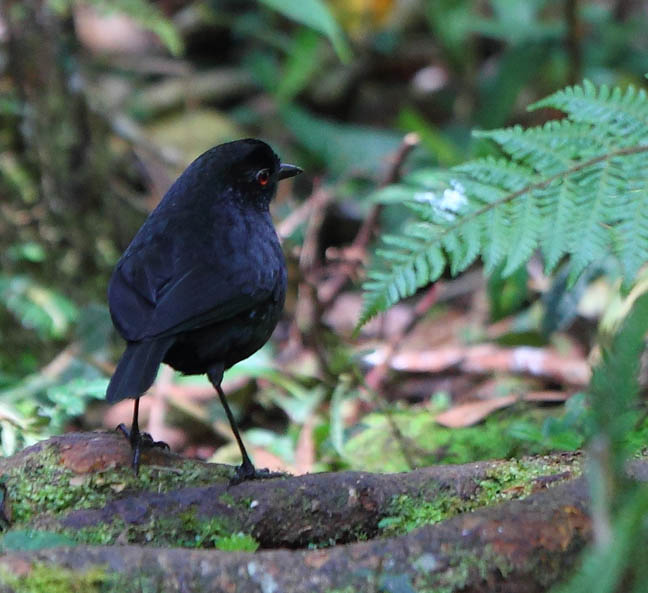
a web page by Don Roberson |
MELAMPITTAS Melampittidae |
|
Melampittas are round-bodied, short-tailed, long-legged, ground-dwelling birds that look rather like an all-black pitta. This is Lesser Melampitta (left, in an amazing shot of a difficult bird taken by Jon Irvine). It is a widespread species in the mountains of New Guinea all the way from the Arfaks in the west to the Huon Peninsula in the east, in cloud forests and up to timberline from 1200-3500m (4000-11,500'), but is reclusive and hard to see. |
Sibley & Ahlquist (1990) published some preliminary biochemical evidence that at least Lesser Melampitta was more closely related to the Paradisaeidae than anything else, but it was a sister group, not part of the birds of paradise clade. Others placed the melampittas among logrunners and allies [Orthonychidae; e.g., Beehler et al. 1986] or the jewel-babblers [what was then called the Eupetidae in the Handbook of the Birds of World series; Boles 2007], and not with birds-of-paradise (Frith & Frith 2009). A number of molecular studies have found the melampittas arose at the base of a clade that led to several current families, including birds-of-paradise (Reddy & Cracraft 2007, Aggerbeck 2014, Claramunt & Cracraft 2015). The most recent and complete study, using 8 nuclear and 4 mitochondrial loci and comparing fossil evidence, provided data that melampittas diverged from the rest of this clade about 22 million years ago, and that their closest relative appears to be the Australasian mudnest-builders (Apostlebirds), the Corcoracidae; Jønsson et al. (2016). The evidence is now conclusive that that the mysterious melampittas of New Guinea are not birds-of-paradise, but that the arose early in the lineage that branched and led to birds of paradise among other families. Reddy & Cracraft (2007) included both melampitta species in their study, and confirmed they were closely related. Schodde & Christidis (2014) proposed full Family status for these two unique species, and this will likely be widely accepted. |
Lesser Melampitta is a bird of high cloud forests, where it hops on 'stilt-like' legs, seeking worms, snails, insects, or small frogs. These are found by flipping leaves, probing, or digging. Physically, it is all-black and has a unique high, domed forehead. Its song can be rendered as "tzee-sisisisisisi, the last series a descending, insect-like trill." The contact note is a "sputtered, loud, double clicking or spitting, like the clicking or grinding of two pebbles," and the bird is most often found by this call-note (Pratt & Beehler 2015). Lesser Melampitta makes a very elaborate nest structure composed of moss worked into side of a tree trunk or tree-fern; a very impressive photo of a bird on the nest is in Coates (1990). Lesser Melampitta is assigned to genus Melampitta, but Greater Melampitta M. gigantea is often placed in its own genus Megalampitta. Greater Melampitta is a mystery bird associated with karst habitat — forested, hilly terrain with sharp-edge limestone formations — where it is known to shelter in sinkholes. It is shy and difficult to see, and best located by its loud, distinctive song. It is strictly terrestrial and "often with an unkempt appearance, particularly the worn, fray tail. Many birds have white feather-mite egg cases encrusted behind the eye;" (Pratt & Beehler 2015). A very strange bird indeed. |
Photos: Jon Irvine photographed the Lesser Melampitta Melampitta lugubris at Kumul Lodge, Mount Hagen, Papua New Guinea, in August 2010. Credited photos © Jon Irvine, as credited, and used with permission; all rights reserved. Many more lovely shots of birds around the world are on Jon's "Calidris" Flckr website. Bibliographic note: There is no "family book" on this new family, but a good introduction to the genus, with photos, is in Boles (2007). The Melampittas were included in the older books on Birds-of-Paradise, such as Gilliard (1969). Literature cited:
|
 The Melampittidae
is comprised of two terrestrial passerines in the montane forests of
New Guinea. The two Melampittas have traditionally been aligned with
the Birds-of-Paradise [Paradisaeidae]; e.g., Gilliard (1969), Coates
(1990), Sibley & Ahlquist (1990). Questions as to this relationship
were raised as early as Firth & Beehler (1998), who did not include
melampittas in their major book on Birds-of-Paradise (more on
relationships below).
The Melampittidae
is comprised of two terrestrial passerines in the montane forests of
New Guinea. The two Melampittas have traditionally been aligned with
the Birds-of-Paradise [Paradisaeidae]; e.g., Gilliard (1969), Coates
(1990), Sibley & Ahlquist (1990). Questions as to this relationship
were raised as early as Firth & Beehler (1998), who did not include
melampittas in their major book on Birds-of-Paradise (more on
relationships below).